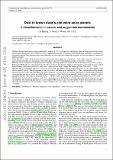Files in this item
Dust in brown dwarfs and extrasolar planets : V. Cloud formation in carbon- and oxygen-rich environments
Item metadata
| dc.contributor.author | Helling, Ch | |
| dc.contributor.author | Tootill, D. | |
| dc.contributor.author | Woitke, P. | |
| dc.contributor.author | Lee, G. | |
| dc.date.accessioned | 2018-08-27T14:30:07Z | |
| dc.date.available | 2018-08-27T14:30:07Z | |
| dc.date.issued | 2017-07 | |
| dc.identifier | 255554706 | |
| dc.identifier | 7c653c2f-7619-42f5-86bb-bc7f32ac5eae | |
| dc.identifier | 85025174078 | |
| dc.identifier | 000406619100039 | |
| dc.identifier.citation | Helling , C , Tootill , D , Woitke , P & Lee , G 2017 , ' Dust in brown dwarfs and extrasolar planets : V. Cloud formation in carbon- and oxygen-rich environments ' , Astronomy and Astrophysics , vol. 603 , A123 . https://doi.org/10.1051/0004-6361/201629696 | en |
| dc.identifier.issn | 0004-6361 | |
| dc.identifier.uri | https://hdl.handle.net/10023/15884 | |
| dc.description | We highlight financial support of the European Community under the FP7 by an ERC starting grant number 257431. A summer scholarship for DT provided by the Royal Astronomical Society is highly acknowledged. | en |
| dc.description.abstract | Context. Recent observations indicate potentially carbon-rich (C/O > 1) exoplanet atmospheres. Spectral fitting methods for brown dwarfs and exoplanets have invoked the C/O ratio as additional parameter but carbon-rich cloud formation modeling is a challenge for the models applied. The determination of the habitable zone for exoplanets requires the treatment of cloud formation in chemically different regimes. Aims. We aim to model cloud formation processes for carbon-rich exoplanetary atmospheres. Disk models show that carbon-rich or near-carbon-rich niches may emerge and cool carbon planets may trace these particular stages of planetary evolution. Methods. We extended our kinetic cloud formation model by including carbon seed formation and the formation of C[s], TiC[s], SiC[s], KCl[s], and MgS[s] by gas-surface reactions. We solved a system of dust moment equations and element conservation for a prescribed Drift-Phoenixatmosphere structure to study how a cloud structure would change with changing initial C/O0 = 0.43...10.0. Results. The seed formation efficiency is lower in carbon-rich atmospheres than in oxygen-rich gases because carbon is a very effective growth species. The consequence is that fewer particles make up a cloud if C/O0 > 1. The cloud particles are smaller in size than in an oxygen-rich atmosphere. An increasing initial C/O ratio does not revert this trend because a much greater abundance of condensible gas species exists in a carbon-rich environment. Cloud particles are generally made of a mix of materials: carbon dominates if C/O0 > 1 and silicates dominate if C/O0 < 1. A carbon content of 80-90% carbon is reached only in extreme cases where C/O0 = 3.0 or 10.0. Conclusions. Carbon-rich atmospheres form clouds that are made of particles of height-dependent mixed compositions, sizes and numbers. The remaining gas phase is far less depleted than in an oxygen-rich atmosphere. Typical tracer molecules are HCN and C2H2 in combination with a featureless, smooth continuum due to a carbonaceous cloud cover, unless the cloud particles become crystalline. | |
| dc.format.extent | 15 | |
| dc.format.extent | 843343 | |
| dc.language.iso | eng | |
| dc.relation.ispartof | Astronomy and Astrophysics | en |
| dc.subject | Astrobiology | en |
| dc.subject | Astrochemistry | en |
| dc.subject | Methods: numerical | en |
| dc.subject | Planets and satellites: atmospheres | en |
| dc.subject | Planets and satellites: gaseous planets | en |
| dc.subject | QB Astronomy | en |
| dc.subject | QC Physics | en |
| dc.subject | Astronomy and Astrophysics | en |
| dc.subject | Space and Planetary Science | en |
| dc.subject | NDAS | en |
| dc.subject.lcc | QB | en |
| dc.subject.lcc | QC | en |
| dc.title | Dust in brown dwarfs and extrasolar planets : V. Cloud formation in carbon- and oxygen-rich environments | en |
| dc.type | Journal article | en |
| dc.contributor.sponsor | European Research Council | en |
| dc.contributor.institution | University of St Andrews. St Andrews Centre for Exoplanet Science | en |
| dc.contributor.institution | University of St Andrews. School of Physics and Astronomy | en |
| dc.identifier.doi | https://doi.org/10.1051/0004-6361/201629696 | |
| dc.description.status | Peer reviewed | en |
| dc.identifier.url | https://arxiv.org/abs/1612.01863 | en |
| dc.identifier.grantnumber | 257431 257431 | en |
This item appears in the following Collection(s)
Items in the St Andrews Research Repository are protected by copyright, with all rights reserved, unless otherwise indicated.

